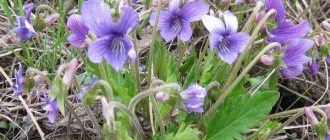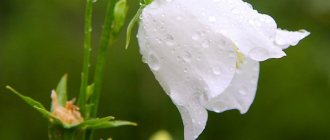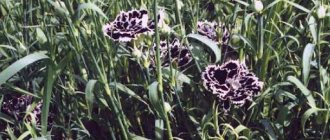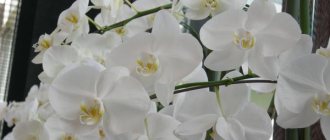White color expands the space and fills it with a feeling of lightness, so decorating the garden with white flowers is a great idea. White petals harmonize with green leaves and create a composition with multi-colored varieties. Flowers can be used in flower beds and bouquets and as decorative elements along paths and borders.
You can plant not only beautiful perennial flowers, but also shrubs. Some varieties of fruit plants have white buds during the flowering period. This method of garden design is popular in design. There is no need to be afraid of monotony; the white palette comes in many shades.
Bulbous
Among the bulbous plants with beautiful white flowers, the lily is famous. The flowers in the garden grow tall and look impressive. When they bloom, the garden is filled with a scent that white lilies retain for a long time. Lily comes in several varieties; you can choose flowers of any shape.
Tulips are also bulbous plants. Beautiful white tulips bloom in the garden in the spring, but the plant's bulbs must be planted in the fall.
If there are not enough tall flowers for the garden composition, you need to plant gladioli. White varieties are full of splendor, the flowers are devoid of monotony and can be used in the garden.
Soft cuff
Soft mantle belongs to that rare category of plants that can bloom throughout almost the entire season. Gardeners love this culture not only for its velvety inflorescences, which during the flowering process change their tone from soft green to pale yellow. If you don’t miss the moment and cut off the faded inflorescences towards the end of summer, the plant will give you a second wave of flowering.
- 15 perennials that bloom all summer
A selection of popular and unusual perennials for the garden!
Perennial flowers
Beautiful perennials have been used for garden decoration for a long time, but they need good care. To ensure large buds, plants with white flowers must be thinned out and fertilized.
Stems with leaves must be cut off before frost. This is how perennial flowers in the garden endure winter better and grow more beautiful.
Delphinium is a typical representative of perennial garden plants with snow-white flowers. When planting, it needs to be given a well-lit place in the garden. Delphinium has beautiful small light flowers that look like eyes.
Small, beautiful flowers add splendor to a garden when planted in a continuous carpet. This is how unusual flower arrangements are made in the garden, and alpine slides are organized in areas.
The most beautiful perennials in the garden are white rose bushes. But white roses get sick, and the bushes need careful care from the beginning of planting. The rose is available in varieties with large and small inflorescences and leaves, it is suitable for decorating any space in the garden.
Iberis evergreen
Iberis belongs to the genus of subshrubs. The perennial barely reaches half a meter in height. The plant has decorative not only flowers, but also leaves. Snow-white Iberis blooms in the spring, flowering lasts about 8 weeks. With good care and favorable weather, the plant can give a second wave of flowering in August.
Spectacular white varieties include: “Snowflake”, “Appen-etz”, “Weisser Zwerg”. Iberis flowers smell pleasant. Despite the fact that the buds are small, the bush looks like a white fluffy cloud, because there are a large number of inflorescences on it.
The bush blooms for the first time in the second year after planting. The evergreen Iberis “Tahoe” blooms its flowers before everyone else. Its flowering begins in April. The plant fits perfectly into any composition and looks great when planted alone.
Flowering shrubs
Shrubs along paths look beautiful and give your garden a luxurious look. Peony is popular in every area; its large petals and leaves deprive the garden space of monotony. At the end of the season, flowers should be cut and bouquets made that will also delight.
Spiraea is a plant with white flowers. The name is known to those who like to create group compositions along the paths of the plots. Among the ornamental plants for the garden, the perennial weigela is common. It has inflorescences of an interesting tubular shape.
On the site you can plant a flowering tree - lilac with snow-white flowers. Peonies bloom with lilacs at the same time, and the garden is filled with an aroma whose splendor cannot be described. If you plant a flowering tree with leaves in the garden, it can be used as a shelter. Often an alley along paths is organized in the garden. This saves from monotony and decorates the garden space.
The viburnum bulldonezh tree also attracts with its large light inflorescences. It is better to trim the bushes, giving them a beautiful shape. These perennials can be used to decorate garden objects. Some bushes are planted near gazebos and garden fences. Climbing perennials become an extension of the garden composition, and when they bloom, they add splendor to your garden.
Chrysanthemum
The perennial blooms in early autumn and decorates the area before the arrival of frost. There are many types and varieties of chrysanthemums with white inflorescences. These flowers are often used for cutting, and then they decorate the interior living space.
In addition to pure white chrysanthemums, there are varieties where the snow-white color of the petals is combined with cream. The varieties look very nice: “Polar Bear”, “Magnum”, “Joy”, “Snow White”, “White Stars”, “Umka”. Many of the chrysanthemums are compact in size, making them suitable for container planting.
Growing poppies on your own site: what types of flowers can be planted in a flower bed
These flowers are so perfect that they do not require framing by other representatives of the flora. Chrysanthemums look best when planted alone against an emerald lawn. The “wow” effect will be achieved by a combination of white flowers and their relatives in a contrasting shade.
White annuals
Not only white perennials are used when decorating a space. Annual decorative flowers and plants also participate in planting. Although the flowers die off in the fall, in the summer they are placed in flower beds, where they remain beautiful and can be enjoyed throughout the flowering period.
Spring
The snowdrop is considered the most springlike. It grows first, then other white bulbous plants bloom, and the time comes for beautiful spring fruit trees and bushes. White tulips create a spring mood in the garden.
When organizing beautiful minimalist areas in the garden, annual spring plants with small white flowers are used for uniformity. They cover the ground well and do not grow large. These flowers include alyssum. This plant blooms in the garden for a very long time.
Summer
In summer, annual flowers and perennials create an amazing ensemble and fill the garden with their aroma. A flower called petunia smells pleasant. In summer it blooms with large beautiful flowers. It is easy to care for, the plant tolerates unfavorable conditions well, and it is necessary to plant it.
The shortest annual plant is called snow-white iberis. The flower size is no more than 30 centimeters. The color of Iberis fully conveys its name.
Dimorphotheca has beautiful white flowers, but they seem simple and full of monotony. It looks like a daisy, with the same center and small petals, but it blooms longer.
If small flowers are not suitable for decorating areas, you can take larger flowers. Datura has large white buds. The shape of the flower resembles a bell. The dimensions of the datura can be more than a meter. It is better to place flower beds with it near the fence and borders.
Autumn
Ageratum blooms until mid-autumn. The color of its flowers does not change for a long time. Some perennials are used as annuals. These flowers include winged tobacco. Only white buds can delight with aroma, and colored tobacco has no smell. Tobacco is popular for planting in clubs. Sometimes other flowers, plants and bushes can be used with it to avoid monotony in the design.
Asters are characteristic of autumn. They also come in white. As a rule, these are large flowers.
Until the end of autumn, bushes of a plant called osteospermum can be used. The description of the plant is similar to that of chamomile. Osteospermum inflorescences also have a center, but are blue. The bushes reach large sizes and tolerate frost and heat equally well.
Winged tobacco Deep Lime
Winged tobacco also has its own “green lines” of varieties and hybrids. For example, Deep Lime from the Cuba series is distinguished by its not too tall growth (25-30 cm), while the Lime Green variety boasts more impressive dimensions - the diameter of its bush can reach 75 cm, and the height almost always exceeds 50 cm.
This plant loves the sun very much and reacts extremely poorly to shade, but when planted in partial shade it can bloom very well, although not as abundantly as tobacco grown in the sun.
About lilies and clematis
The first flowering of clematis should be expected no earlier than June 10. If semi-double flowers are of irregular shape, it means this is last year's shoot. Clematis Lucie is similar to the double dahlia, so it can easily replace it in the flowerbed. If you prefer domestic varieties, choose among such as “Ballerina”, “Polar” and “V. V. Sharonova.” The clematis wattle will decorate the area until the end of September.
An equally popular exotic plant that is easy to find on the domestic market is the giant lily. White lily flowers are striking in their size, often reaching a length of 17 cm; the peduncle itself can grow up to 2.5 m long. With proper care, there are about 20 flowers on each inflorescence.
The giant lily bulb is planted in October, for this purpose acidic soil and a slightly shaded place are prepared. We can talk about the appearance of the first flower stalks only after one or two years. If you want to grow a full-fledged plant from baby bulbs, you will have to wait at least three years.
Clematis Yukiokoshi
Yukiokoshi is a very old clematis variety of the second pruning group. It is distinguished by large double or semi-double flowers of a greenish or yellowish-white hue.
A compact shrub that prefers sunny places well protected from the wind, but can also thrive in partial shade.
- What types of clematis are there - review of groups, best varieties (photo)
Let's figure out which clematis to plant in the garden so as not to make a mistake.
The above list of plants is far from complete, but it allows us to appreciate the beauty and diversity of crops with flowers of such an unusual green color.
Shrubs with white flowers
At the beginning of summer, the flower begins to go wild, the photo of which is given below, is a French lilac, bred by the Lemoine family. The flowers of densely double white lilac reach 3 cm in diameter and are collected in large inflorescences. The Vestale variety has simpler flowers that amaze with their bright aroma.
Buddleya Davida is unpretentious throughout the entire period from mid-July to October. The arrow-shaped inflorescences, which Her Majesty Nature collected from tiny flowers, have a breathtaking honey aroma. The pruning process requires special attention when caring for the plant. Every year in April, last year's growths are cut off, otherwise the bush can reach a height of 3 m, spending all its energy on the growth of shoots.
If you want to diversify your snow-white meadow with small splashes of color, plant hibiscus. The Kopper King variety has large white flowers with a bright crimson center. Belongs to frost-resistant species. White hibiscus "Hibiscus" is well known and beloved by gardeners. The perennial plant can grow to a height of 1.5 m, and numerous flowers reach a diameter of 14 cm. The advantage of planting hibiscus is the opportunity to see the first flowers in the first year of planting. It will be appropriate on lawns, flower beds and even on the windowsill.
Autumn season in the garden
Asters and chrysanthemums open the autumn season. There are a lot of varieties of these flowers and breeders do not stop there. There are unpretentious species, and there are also very capricious ones. Therefore, when choosing, you should be guided by the time that you are willing to spend on caring for these flowers.
Hydrangea has a long flowering period, which begins in summer and ends in late autumn. This plant is distinguished by its woody stem. Therefore, it is often mistaken for a shrub. It can be a true decoration of the garden, thanks to its spherical inflorescences consisting of many small flowers. Looks very nice!
We have looked at only a small part of the endless variety of white colors that exist in nature. However, the very idea of creating such a garden is worthy of attention.
Summer "snow whites"
When considering a flower with white flowers, one cannot help but mention irises - rhizomatous and bulbous varieties that fit harmoniously into any garden. Already at the end of May, the first reticulate irises appear, which reproduce well by dividing the nest. Perennial flowering, even in shade, is achieved by the White Excelsior and White and Violet varieties.
If you haven't found your white-flowered flower yet, check out the peonies that bloom in mid-June. From the group of hybrid varieties, the Sonet and Gold Standart varieties are of greatest interest. The former are clearly recognizable by their large white flowers with a pink tint, the latter have a bright yellow center. A good semi-double variety is Minne Shaylor with lush white flowers. When choosing such flowers for your front garden, remember that they will need a lot of space; the height of the bushes can reach one meter.
"Women's happiness" or spathiphyllum
These white flowers, similar to miniature calla lilies, are popularly called “Women’s Happiness”, and its Latin name is Spathiphyllum. They are easy to care for and therefore are one of the desired decorations in many homes and offices. All they need is adherence to a certain regime of watering and humidity, access to light without direct rays of the sun, spraying and fertilizing from spring to autumn.
All existing hybrids differ from each other in the size of the bud and the size of the bush. These plants of the Araceae family delight their owners with their white flowers for several weeks.
Spathiphyllum is propagated by dividing the bush or by seeds. It is better to plant it in a wide pot of small depth.
By the way, spathiphyllums have beneficial properties, for which they are extremely valued in preschool institutions. Plants are able to process toxic substances emitted by furniture, reduce the content of harmful substances in the air - benzene and trichlorethylene, and also emit ozone.
Silver lily of the valley
These white flowers cannot be confused with any others - lilies of the valley open the May holidays. There is a forest species familiar to everyone, as well as decorative ones that differ from it in larger flowers. Their shape can vary from terry to the one we are accustomed to since childhood. The leaves also come in a somewhat unusual striped color. By the way, this can be used as an independent garden decoration.
Lily of the valley loves shade and reproduces by root division. If this process is not controlled, the plant will fill the entire area, displacing less tenacious flowers. After flowering, lily of the valley forms red-orange pea seeds located on the stem. Falling onto the soil, they germinate the following spring. After 5 years, lilies of the valley need to be replanted.
It should be noted that lily of the valley not only provides aesthetic pleasure, but is also used as a medicinal plant. A tincture is made from it to strengthen the heart muscle.
Impatiens or impatiens
There are a great many varieties of this white flower, whose name is Impatiens or Impatiens (Latin IMPATIENS). Sometimes it is called Touchy. There are species that are basic, such as Waller's Impatiens, characterized by a tall stem.
Numerous modifications have come from them, the characteristic feature of which is their compactness and countless shades, among which there are both pure white and interspersed with other colors. To prevent these plants from growing tall, they need to be pinched.
The most spectacular representatives of balsam were bred in New Guinea, but their flowering period is only in summer. Their care is standard.
Like many indoor plants, balsam calmly waits out the winter at a temperature of at least 13 degrees and moderate watering. He does not like direct sunlight, but he needs light. Starting in spring, it requires increasing soil moisture and spraying. It can be propagated at any time of the year by cuttings.
Recipes based on snow-white lily
Oil
Place three chopped lily stems along with flowers in a half-liter jar. Fill the jar completely with vegetable or olive oil. Place in the refrigerator and shake occasionally for 2 weeks. Use for regular and purulent wounds, boils and burns in the form of lotions 2 times a day. Store for no more than 1 year.
Tincture for dropsy, improving performance and boosting immunity
50 g of fresh chopped white lily bulbs pour 500 ml of vodka. put in a dark place and leave for a month, shaking occasionally. Take 25 drops 15-20 minutes before meals 3 times a day.
Tincture for the treatment of cancer
Chop 6-7 large onions into a three-liter jar. Pour alcohol up to the neck and leave for 2 weeks in a cool, dark place. Three times a day, 2 hours before meals, you need to consume 30 ml of tincture. But before that, drink a raw chicken egg with a small piece of butter. The course of treatment includes 3 three-liter jars of tincture.
Mixture for the treatment of diseases of the respiratory system and colds
This mixture is prepared in advance in the summer. Crush 40-45 fresh lily flowers or grind through a meat grinder. Mix with 1 kg of honey and cover tightly with a lid. Take 3 times a day, 30-40 minutes before meals, 0.5 teaspoon. Dissolve the mass as slowly as possible. Keep refrigerated.
Tincture for varicose veins
1 tablespoon of flower leaves is poured with 250 ml of vodka. Leave for a week in a cool, dark place. Rub your feet morning and evening. During the evening procedure, it is advisable to wrap your feet for the whole night.
Calming Infusion
Brew 20 g of white lily flowers in a liter of boiling water. Leave for 50-60 minutes. Filter and take 1 tablespoon morning and evening. Also, this infusion can be used as a microenema for hemorrhoids.
Planting and care
The snow-white lily is quite picky about the planting site. Some gardeners replant it several times until they find a place that suits the flower in all respects. Although this plant does not tolerate frequent transplants very well. Growing plants in acidic soil is impossible. It will hurt and grow poorly. But lime in the soil will help candidum develop well. It is also necessary to fertilize and drain the soil well to avoid stagnation of water at the roots. For planting, it is important to choose the least sunny day or evening time at the end of August, when the leaves have not yet appeared or have just begun to hatch. The plant bulb is not inserted deep into the soil. A hole of 3-4 cm is enough.
At the age of 4-5 years, the white lily weakens and the flowers begin to become smaller. This means it’s time to transplant and divide the bulb. If you notice signs of the disease earlier, then transplantation should be done immediately.
The lily stems are cut as short as possible and get to work right away without allowing the roots to wilt. It is better to transplant candidum after about a month to a month and a half has passed after flowering. It is important to thoroughly water the new hole for the bulb in advance. Its depth should be 3 times greater than the bulb itself. The soil is not compacted, but added as it shrinks. In case of drought, it is better to water the planting site a little. A distance of 20-25 cm must be maintained between the bulbs.
Fertilizer
It will never be superfluous to feed a snow-white flower; it will only thank you for it with its abundant and lush flowering. Ash is the easiest and most reliable way to fertilize a plant. It can be applied both before flowering and during. A good way to prevent diseases is to spray and water with a solution of potassium permanganate during the growing season. This procedure can be repeated every month. Complex mineral fertilizers can also be used several times during flowering. Preparation for winter is an integral part of feeding the plant for the next year. The white lily does not tolerate severe frosts very well and may suffer. Fallen leaves or spruce branches will be an excellent protection for the flower in the harsh winter. It is necessary to generously cover the rosette of the plant with them, and remove them in the spring, since spring frosts are not terrible for the lily.
Pests
The snow-white petals of candidum often attract pests. Therefore, it is necessary to periodically inspect the plant for the presence of red beetle larvae. Their larvae are very similar in appearance to the larvae of Colorado potato beetles. They feed on the leaves of the plant, leaving black marks on the eaten places. If these symptoms are detected, the snow-white lily should be immediately treated with special solutions that are suitable for combating the Colorado potato beetle. The scent of the lily also attracts the bronze beetle. They are not as harmful as red beetles. These beetles feed on flower pollen. The use of special means against this insect is not required; it can simply be shaken off from the candidum.
The most common and dangerous diseases of white lily are:
- Fusarium. With this disease, the bulb is affected. The plant gradually withers and dies. Having dug up and examined the bulb, you can see brown spots on its scales. Very hot or wet weather is an ideal environment for fusarium to develop. This disease must be prevented immediately and the snow-white lily bulb must be soaked in a solution of the drug Maxim or potassium permanganate before planting. You can water the plant several times a season with the same preparations for prevention.
- Botrytiosis. The plant bulb is not affected. The entire disease occurs on the leaves of the plant. They become covered with whitish spots and gradually die off. During rainy summers, this disease develops in 80% of cases. Therefore, it is worth carrying out prevention and spraying the leaves with foundationazole or Bordeaux mixture. These drugs can also be used to treat already affected foliage.
- Tobacco and cucumber mosaic. This is a viral disease transmitted by aphids. Flowers and leaves are affected, becoming covered with whitish stains and spots. The plant does not develop, and the leaves and flowers die off. Using karbofos as a disinfectant will help.
- Rosette. It is also a viral disease that is transmitted by insect pests (flower thrips, aphids, lily flies, spider mites, wireworms). This disease leads to thickening of the stems. They acquire a yellowish tint, and the plant does not bloom. Snow-white lily also needs to be treated with karbofos.
Rose Limbaugh
Photo ludwigsroses.co.za
Limbo is one of the most popular varieties of “green” roses. Since varieties with a pure green color do not yet exist, varieties and hybrids with petals of yellow-green tones are usually included in this group. The buds are cone-shaped, the petals have a scalloped edge.
The flowers, consisting of 45-47 petals, form a 7-8 cm cup when fully opened. One of the main advantages of this rose is that its flowers can remain on the bush for a long time. In addition, many rose growers note that if the plant is fed in a timely manner and faded buds are removed, it will bloom again.
- Roses for beginner gardeners: 10 popular varieties
What varieties of roses should a summer resident who is just beginning to master the intricacies of caring for this capricious flower choose?
About May daffodils and tulips
The white flower (photo) with a yellow center is a representative of the daffodil family. These garden flowers, which are associated with narcissism and selfishness, are found in front gardens and flower beds on all continents. To create a snow-white composition, choose flowers from Mount Hood, WPMilner and Desdemona. The late variety Double White Poeticus, well recognizable by its double white flowers and exotic star-shaped shape, has taken root perfectly in our homeland. When choosing a flower with white flowers for winter forcing, pay attention to the Mount Hood and Cheerfulness varieties.
Tulips are garden flowers whose names are familiar to everyone. The early white varieties Snow Queen and Snowstorm bloom first. When creating a garden composition, pink and blue forget-me-nots will help highlight the beauty of tulips. Low-growing tulips will stand out against the background of muscari, crocuses, chionodox, hyacinths and cold-resistant violas. Sweet Lady is the smallest variety of tulips, the height of which reaches no more than 15 cm. Excellent reproduction and the absence of the need for annual digging of bulbs helped them become favorites of gardeners.
Hyacinths are also spring flowers and are very popular among Russian gardeners. Dutch hybrids, which have dense, waxy inflorescences, have gained particular love. The Carnegie variety is suitable for forcing in January.











